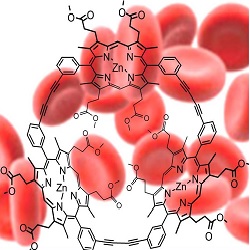
Porphyrins are found in almost every life form on earth and we’ve been studying them for over 100 years, yet we still can’t tell you everything about these multifunctional cofactors. In the early days of porphyrin science the only way to get hold of these intensely coloured molecules was by visiting abattoirs, collecting pints of pigs blood and then carrying out painstaking extraction and purification. Since then the synthetic guile of chemists has increased substantially so that I am now spared that bloody experience in order to obtain my purple crystals, but don’t be fooled it’s still not a facile process.
The difficulty in obtaining haem, or analogues thereof, negates commercial viability for most technological applications – so why study it? Simple: The core principle of academic science is to develop knowledge and understanding of the natural world. Porphyrins offer a colourful window into many areas of the physical and biological sciences and my research works to add more understanding to this already significant tome of knowledge.
Below is a summary my research topics:
We have assembled cyclic porphyrin trimers (see figure) into 3D network polymers and 2D monolayers. The strength of these monolayers can then be tuned by addition of a simple ligand, before transfer onto solid surfaces. Adsorbed onto solid substrates these films can bind peptides, hopefully leading to a system that can bind proteins onto surfaces without disrupting their structure and function as well as reporting on chemical reactions.
Synthesis of novel porphyrin cyclic trimers allows us to investigate and quantify molecular motion, rotation and energies connecting experimental and computational results in order to gain understanding into how changes in the porphyrin structure effect molecular motion and chemical behaviour.
New multi-metal porphyrin systems that can absorb light and reduce carbon dioxide into a useful fuel-source are adding to our understanding of how to harness natural light and convert this dangerous green-house gas into a clean fuel source.
In addition, I worked on a project that used polymer scaffolds to produce intricate gold-wire networks that act as high-transmission waveguides.
I am always happy to discuss my research-if you would like to know more, please email me.
Julian Philpott
NanoDTC PhD Student Cohort 2011
Publications:
Salvatore S, Vignolini S, Philpott J, Stefik M, Wiesner U, Baumberg JJ, Steiner U. “A high transmission wave-guide wire network made by self-assembly.” Nanoscale, 2015, 21, 7(3):1032-6. DOI: 10.1039/c4nr04485a

